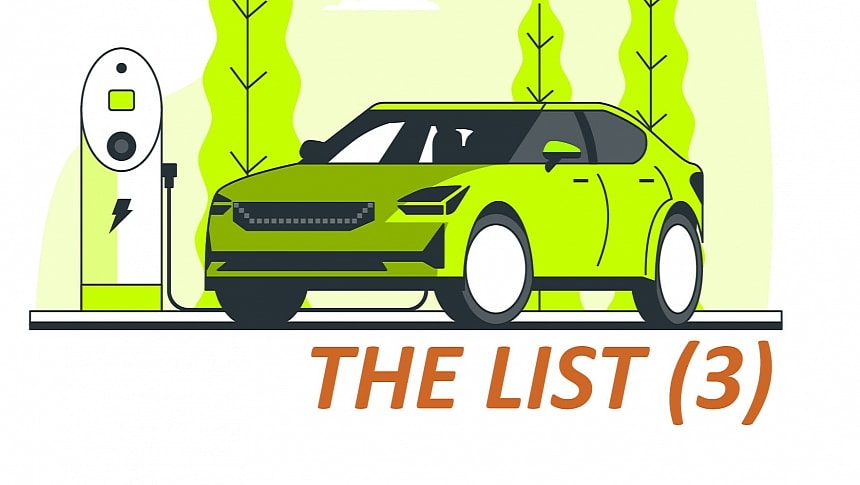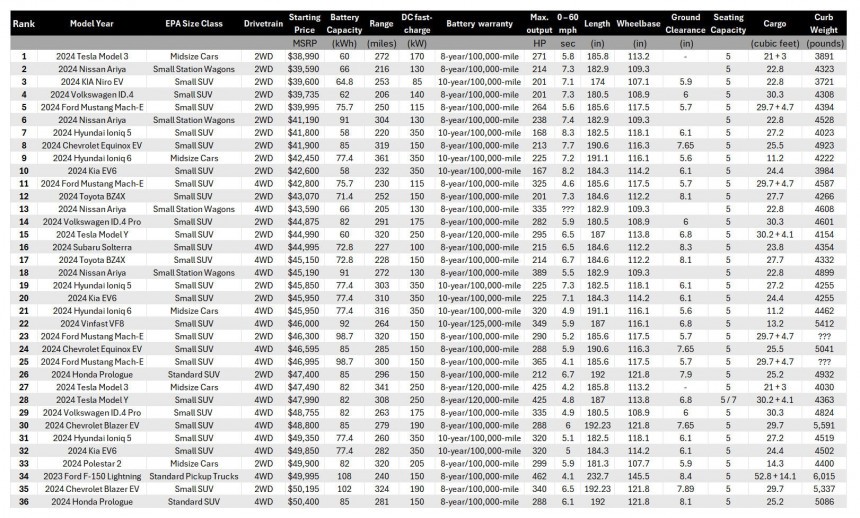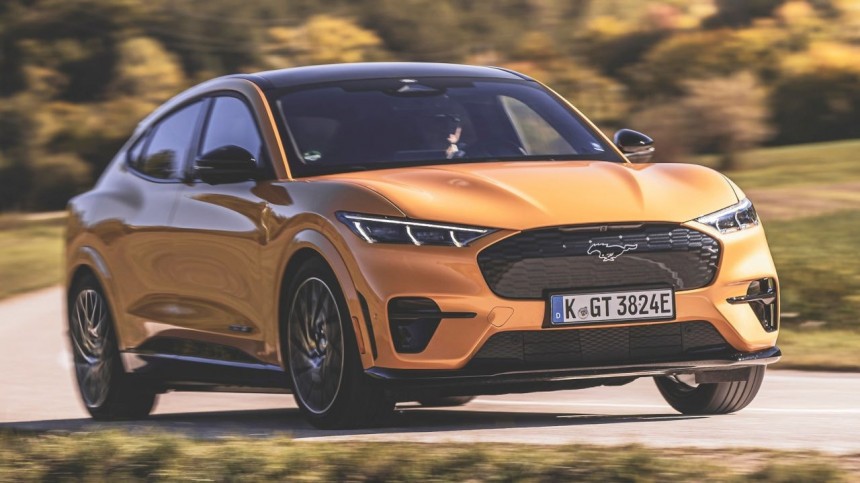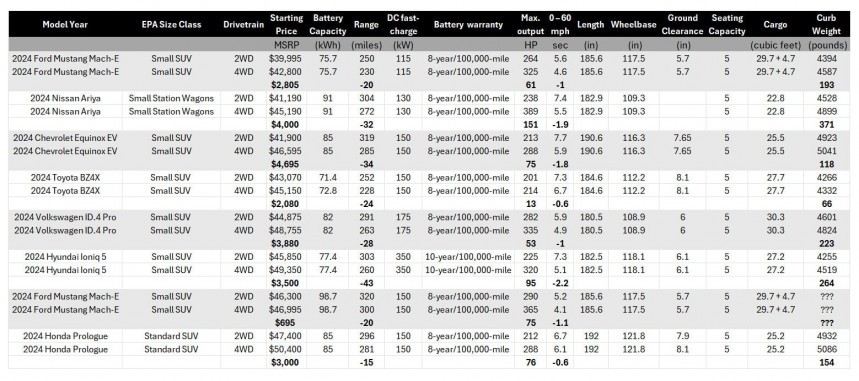Currently, there aren't many reasons for an American to buy an affordable EV costing less than $40,000. However, you'd be mistaken to think things are the same in the $40-50,000 price range. They're totally different.
In the previous part of this series, I tried to objectively analyze the feasibility of affordable EVs. Conclusions were grim for the electrohead in me. Now it's time to move on – here is the list of the variants in the $40-50,000 basic MSRP price range:
Frankly, I expected most of the EVs in this price range to showcase ranges of at least 300 miles, but to my surprise, there are only a few such examples. For instance, the average range for the EV variants in the table is around 270 miles, while the average battery capacity is nearly 80 kWh.
You would expect at least 300 miles from an electric car sporting an 80-kWh battery, right? Well, it's not the case. Moreover, the average range for all the variants on my bigger list (more than 150, remember?) is roughly 290 miles, while the average for all the batteries' capacities is almost 100 kWh.
Just for context, the Tesla Model S with the 100-kWh battery pack is good for the 400-mile range. This is a heavy 4WD sedan, rated at 4,500 lbs, but capable of 3.1 seconds for 0-60 mph, which rivals the best ICE sports cars out there. And get this: the basic MSRP price is $73,000, less than the average basic price of $76,000 for all the vehicles on the big list.
These statistics only reveal that the current EV market in the US isn't on par with the vast majority of customers' expectations. The "market cool down" is mainly because the EV early adopters' wave has passed.
Now, those willing to make the switch but not ready to compromise big time on range and charging comfort have more electric cars to choose from. Unfortunately, while battery tech has evolved tremendously in the last decade, it's not yet a serious contender for ICE-based vehicles, whether gasoline engines or hybrid powertrains.
On the bright side, the $40-50,000 price range table reveals that many EVs are suited for ultra-fast charging capabilities, a welcome bonus for tackling range anxiety on long journeys. I should also point out that "SUV mania" is largely responsible for not-so-convincing range values.
And one more thing: these cars are too fast for what you'd expect from an ICE car in this price range. The entry-level Ford Mustang Mach-E can sprint to 60 mph in just 5.6 seconds – do you still think it's expensive at $40,000?
The $46,000 Hyundai Ioniq 6 needs 4.9 seconds to go from 0 to 60 mph, while the electric F-150 Lightning, with a big 108-kWh battery and a hefty 6,000 lbs, needs only 4.1 seconds. This is truly remarkable for a $50,000 pickup truck, right?
The EVs in the $40-50,000 price range have an average acceleration time of only 6.1 seconds from 0 to 60 mph. The average value for all those electric motors' power is around 280 hp. Keep in mind that most of them are SUVs, with around 6-7 inches of ground clearance.
It seems that carmakers decided to play the irrational card of sportiness to counteract the lower-than-desired range. Because they can and because a century of slowly increasing performances of ICE cars imprinted in our mind that, first of all, a car must be fast. Very fast.
Well, you know, electric motors are not only simpler than internal combustion engines. They are also much more efficient and can be easily tweaked to be more powerful. Oh, and because they are smaller, converting an EV into an AWD is like a walk in the park – at least compared to how complicated it is to implement an all-wheel drive into an ICE car.
The table below provides several comparisons between the 2WD and 4WD variants of the same model. The models in this table prove a point: the 4WD adds more performance for more money and more weight but at the cost of range.
With ICE or hybrid cars, the 4WD system costs more, weighs more, and consumes more fuel, but engine power is generally the same, while performance is slightly affected by the extra weight. 4WD EVs have a great advantage here because a second electric motor means more or much more power.
On average, the 4WD variants in this table add an average of 80 hp and are at least one second faster for the 0-60 mph. The average cost increase is around $3,000, less than 10% of the 2WD starting price. This is a very good trade-off if you like a sporty car…
In that respect, I would go for the Ford Mustang Mach-E AWD with the smaller battery, as the range loss is insignificant compared to the performance increase, while the price hike is decent. However, I suspect that for most prospective customers in the $40-50,000 price range, a less than 300-mile range is an obstacle that is hard to overcome.
Frankly, it's not a fair comparison because the EV is at least one second quicker, while Escape's fuel economy of around 25 mpg helps the EV quickly break even. However, a range of at most 250 miles is very challenging for the electric car, as expected.
The bottom line is that cars and SUVs in the $40-50,000 price range usually perform better than their comparable ICE or hybrid counterparts, but range remains an issue, especially given the all-around capabilities people expect from SUVs.
What about electric cars starting from $50,000? Are they worth it, or would you be better off with an ICE or hybrid one? We'll get into that in the next part of this material.
You would expect at least 300 miles from an electric car sporting an 80-kWh battery, right? Well, it's not the case. Moreover, the average range for all the variants on my bigger list (more than 150, remember?) is roughly 290 miles, while the average for all the batteries' capacities is almost 100 kWh.
Just for context, the Tesla Model S with the 100-kWh battery pack is good for the 400-mile range. This is a heavy 4WD sedan, rated at 4,500 lbs, but capable of 3.1 seconds for 0-60 mph, which rivals the best ICE sports cars out there. And get this: the basic MSRP price is $73,000, less than the average basic price of $76,000 for all the vehicles on the big list.
These statistics only reveal that the current EV market in the US isn't on par with the vast majority of customers' expectations. The "market cool down" is mainly because the EV early adopters' wave has passed.
Now, those willing to make the switch but not ready to compromise big time on range and charging comfort have more electric cars to choose from. Unfortunately, while battery tech has evolved tremendously in the last decade, it's not yet a serious contender for ICE-based vehicles, whether gasoline engines or hybrid powertrains.
On the bright side, the $40-50,000 price range table reveals that many EVs are suited for ultra-fast charging capabilities, a welcome bonus for tackling range anxiety on long journeys. I should also point out that "SUV mania" is largely responsible for not-so-convincing range values.
If it's an SUV, it gotta have all-wheel drive, right?
The average curb weight for the EVs in this table is more than 4,500 lbs. Large batteries are pretty heavy, of course, but SUVs also add weight because they are bigger than regular cars, they use more steel and other materials, their aerodynamics are worse, bigger tires lead to more rolling resistance, and so on.And one more thing: these cars are too fast for what you'd expect from an ICE car in this price range. The entry-level Ford Mustang Mach-E can sprint to 60 mph in just 5.6 seconds – do you still think it's expensive at $40,000?
The EVs in the $40-50,000 price range have an average acceleration time of only 6.1 seconds from 0 to 60 mph. The average value for all those electric motors' power is around 280 hp. Keep in mind that most of them are SUVs, with around 6-7 inches of ground clearance.
It seems that carmakers decided to play the irrational card of sportiness to counteract the lower-than-desired range. Because they can and because a century of slowly increasing performances of ICE cars imprinted in our mind that, first of all, a car must be fast. Very fast.
Well, you know, electric motors are not only simpler than internal combustion engines. They are also much more efficient and can be easily tweaked to be more powerful. Oh, and because they are smaller, converting an EV into an AWD is like a walk in the park – at least compared to how complicated it is to implement an all-wheel drive into an ICE car.
The table below provides several comparisons between the 2WD and 4WD variants of the same model. The models in this table prove a point: the 4WD adds more performance for more money and more weight but at the cost of range.
On average, the 4WD variants in this table add an average of 80 hp and are at least one second faster for the 0-60 mph. The average cost increase is around $3,000, less than 10% of the 2WD starting price. This is a very good trade-off if you like a sporty car…
…but is it a good one in terms of range loss?
On average, the range decreases by around 25 miles, less than 10% of the advertised range of the 2WD variants. It's up to you to decide if you're willing to own a sub-300-mile but pretty fast electric car or SUV.In that respect, I would go for the Ford Mustang Mach-E AWD with the smaller battery, as the range loss is insignificant compared to the performance increase, while the price hike is decent. However, I suspect that for most prospective customers in the $40-50,000 price range, a less than 300-mile range is an obstacle that is hard to overcome.
As for the most affordable Mustang Mach-E with a 264-hp electric motor, I can only compare it to its ICE sibling Escape, which has a 2.0L EcoBoost AWD and 250 hp and starts from around $35,000 (almost five grand less than the Mustang Mach-E).
The bottom line is that cars and SUVs in the $40-50,000 price range usually perform better than their comparable ICE or hybrid counterparts, but range remains an issue, especially given the all-around capabilities people expect from SUVs.
What about electric cars starting from $50,000? Are they worth it, or would you be better off with an ICE or hybrid one? We'll get into that in the next part of this material.









